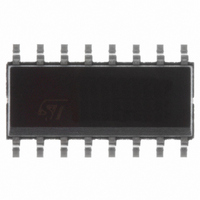L6566B STMicroelectronics, L6566B Datasheet - Page 9

L6566B
Manufacturer Part Number
L6566B
Description
IC CTRLR OVP OTP UVLO HV 16SOIC
Manufacturer
STMicroelectronics
Datasheet
1.L6566BTR.pdf
(51 pages)
Specifications of L6566B
Output Isolation
Isolated
Frequency Range
10 ~ 300kHz
Voltage - Input
8 ~ 23 V
Power (watts)
750mW
Operating Temperature
-40°C ~ 150°C
Package / Case
16-SOIC (0.154", 3.90mm Width)
Output Current
800 mA
Output Power
750 mW
Input Voltage
8 V to 23 V
Operating Temperature Range
- 40 C to + 150 C
Mounting Style
SMD/SMT
Duty Cycle (max)
75 %
Selectable Multi-mode Operation
fixed frequency or quasi-resonant
For Use With
497-6452 - BOARD EVAL FOR L6566B497-6451 - BOARD EVAL FOR L6566B497-6450 - BOARD EVAL FOR L6566B497-6449 - BOARD EVAL FOR L6566A
Lead Free Status / RoHS Status
Lead free / RoHS Compliant
Available stocks
Company
Part Number
Manufacturer
Quantity
Price
Part Number:
L6566B
Manufacturer:
ST
Quantity:
20 000
Part Number:
L6566BHTR
Manufacturer:
ST
Quantity:
20 000
Part Number:
L6566BTR-13
Manufacturer:
ST
Quantity:
20 000
L6566B
Table 1.
N°
10
5
6
7
8
9
COMP
FMOD
VREF
Vcc
DIS
Pin
CS
Pin functions (continued)
Supply voltage of both the signal part of the IC and the gate driver. The internal
high voltage generator charges an electrolytic capacitor connected between this
pin and GND (pin 3) as long as the voltage on the pin is below the turn-on threshold
of the IC, after that it is disabled and the chip is turned on. The IC is disabled as the
voltage on the pin falls below the UVLO threshold. This threshold is reduced at light
load to counteract the natural reduction of the self-supply voltage. Sometimes a
small bypass capacitor (0.1 µF typ.) to GND might be useful to get a clean bias
voltage for the signal part of the IC.
Frequency modulation input. When FF mode operation is selected, a capacitor
connected from this pin to GND (pin 3) is alternately charged and discharged by
internal current sources. As a result, the voltage on the pin is a symmetrical
triangular waveform with the frequency related to the capacitance value. By
connecting a resistor from this pin to pin 13 (OSC) it is possible to modulate the
current sourced by the OSC pin and then the oscillator frequency. This modulation
is to reduce the peak value of EMI emissions by means of a spread-spectrum
action. If the function is not used, the pin will be left open.
Input to the PWM comparator. The current flowing in the MOSFET is sensed
through a resistor, the resulting voltage is applied to this pin and compared with an
internal reference to determine MOSFET’s turn-off. The pin is equipped with 150 ns
min. blanking time after the gate-drive output goes high for improved noise
immunity. A second comparison level located at 1.5 V latches the device off and
reduces its consumption in case of transformer saturation or secondary diode short
circuit. The information is latched until the voltage on the Vcc pin (5) goes below
the UVLO threshold, hence resulting in intermittent operation. A logic circuit
improves sensitivity to temporary disturbances.
IC’s latched disable input. Internally the pin connects a comparator that, when the
voltage on the pin exceeds 4.5 V, latches off the IC and brings its consumption to a
lower value. The latch is cleared as the voltage on the Vcc pin (5) goes below the
UVLO threshold, but the HV generator keeps the Vcc voltage high (see pin 1
description). It is then necessary to recycle the input power to restart the IC. For a
quick restart pull pin 16 (AC_OK) below the disable threshold (see pin 16
description). Bypass the pin with a capacitor to GND (pin 3) to reduce noise pick-
up. Ground the pin if the function is not used.
Control input for loop regulation. The pin will be driven by the phototransistor
(emitter-grounded) of an optocoupler to modulate its voltage by modulating the
current sunk. A capacitor placed between the pin and GND (3), as close to the IC
as possible to reduce noise pick-up, sets a pole in the output-to-control transfer
function. The dynamics of the pin is in the 2.5 to 5 V range. A voltage below an
internally defined threshold activates burst-mode operation. The voltage at the pin
is bottom-clamped at about 2 V. If the clamp is externally overridden and the
voltage is pulled below 1.4 V the IC will shut down.
An internal generator furnishes an accurate voltage reference (5 V ± 2 %) that can
be used to supply few mA to an external circuit. A small film capacitor (0.1 µF typ.),
connected between this pin and GND (3), is recommended to ensure the stability of
the generator and to prevent noise from affecting the reference. This reference is
internally monitored by a separate auxiliary reference and any failure or drift will
cause the IC to latch off.
Function
Pin settings
9/51













